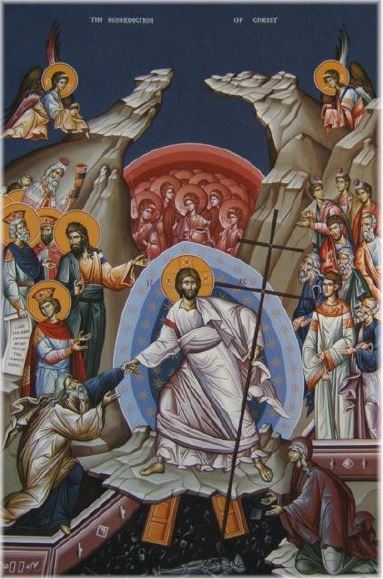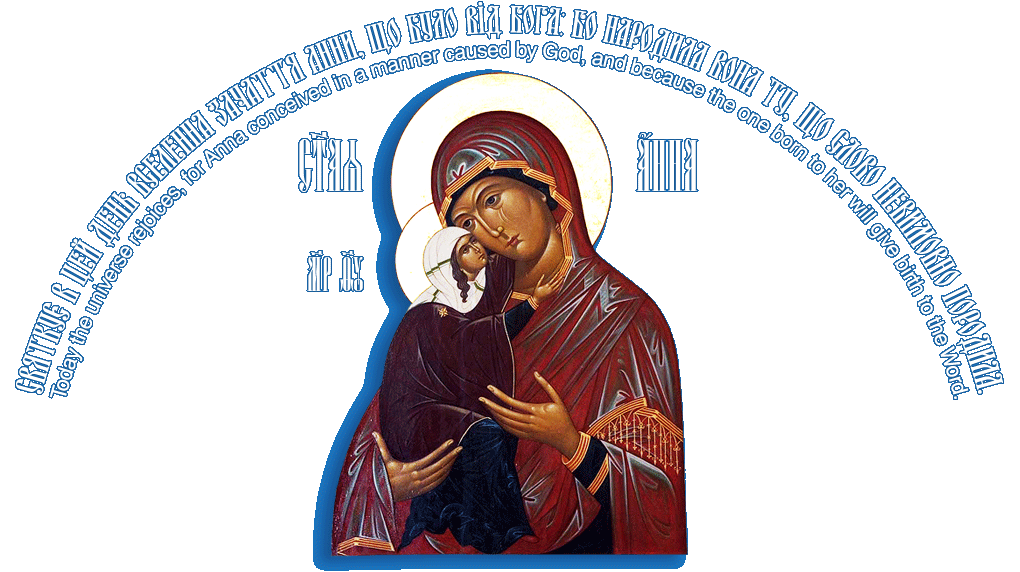Resurrection Icon
 “Christ is Risen from the dead, trampling down death by death; and upon those in the tombs bestowing life”
“Christ is Risen from the dead, trampling down death by death; and upon those in the tombs bestowing life”
The Resurrection Icon is one that reassures and inspires the faithful on this Feast of Feasts. The icon also, however, is an invitation to join with Christ and especially to learn about all that is happening in this very moment.
- Christ’s cape/robe is flowing upward, this symbolizes his radical and powerful descent into Hades to save all who have died.
- The gold-coloured bars by his feet are the gates of Hades, which he has broken and torn apart. There are keys floating in the abyss below, which symbolizes that he has entered and conquered both death and Hades. The broken locks and fragments of chain represent the crushed, scattered and destroyed traps and snares of the adversary which Christ overthrew when he encountered death.
- You may also note the skeletal figure who is chained up: that is Death. He has been bound and killed by Christ (all throughout Pascha we sing “Christ is Risen from the dead, trampling down death by death; and to those in the tombs bestowing life”).We are no longer eternally chained to death, but can actively choose to live with Christ. (Romans 6:3-11)
- The two figures whom Christ has grasped and is pulling upward are Adam and Eve, symbolizing that this victory redeems all mankind, even back to the beginning. This resurrection scene is taking place in the past, present, and future. This sense of being outside of a measured and always linear time can be a difficult one for the “modern mind” to comprehend.
- To his left, we see three characters: David and Solomon, two of his ancestors according to his fleshly nature. We also see, closest to him Saint John the Baptist, who was his forerunner in both life and death.
- On the right, we have the apostles who are alive. The purpose is to show that Christ’s redemption transcends time and space. You could very well picture yourself on the right side, coming to Christ as he is breaking down the gates of Hades and setting the captives free. As alluded to above, Christ transcends the constraints of time and space. This is an act that happened in the past, is happening right now, and will happen in the future. Christ is always in the state of redeeming and setting us free.
- Behind, and above Christ are the assembled Bodiless Hosts. It is through the prayer, guidance, defence and wisdom provided by our Guardian Angel that we are able to make our journey through this life to the one shown here with Christ. The pious and observant Orthodox are called by Christ to “Come and follow me” both as individuals but also as a family (indeed, a team) united in purpose and love as shown by the entire assembly in the Holy Icon. As we gather at the Holy Altar we sing hymns of praise and adoration in like manner to them. “For You are praised by the angels, archangels, thrones, dominions, principalities, authorities, powers, and the many eyed Cherubim. Round about You stand the Seraphim.” “O Christ! Great and most holy Pascha! O Wisdom, Word, and Power of God! Grant that we may more perfectly partake of You in the never-ending Day of Your Kingdom.” (from the Divine Liturgy of Saint Basil)
- The blue shape around Christ is called the Mandorla (which is Italian for almond, which describes its shape). The Mandorla is the uncreated, eternal metaphysical light of Christ. In the writings of the Orthodox mystics, God is often prayerfully experienced as light. This is not simply a pretty bright light. It is the same light which filled the apostles with wonder when they witnessed His Transfiguration. It is the light which Christ Himself described as the power of the Kingdom of God (Mark 9:1 Matt 16:28 Luke 9:27; John 1:4-9). It is the light that filled the once perpetual darkness of Hades when Christ descended and brought life into the realm of death. It is also the light that is seen when one purifies their heart and mind (Blessed are the pure in heart, for they shall see God.)
- The Mandorla progressively becomes darker as it moves toward Christ. If God is represented by light, the Mandorla may seem confusing. However, those who seek God will find that the more they know Him, the less they comprehend Him. To know God, to experience Him, is to walk in the darkness of His light, to enter into the mystery of His presence.
From the Paschal Matins:
“It is the Day of Resurrection, let us be radiant for the feast, and let us embrace one another. Let us say, Brethren, even to them that hate us, let us forgive all things on the Resurrection, and thus let us cry out: Christ is risen from the dead, trampling down death by death, and upon those in the tombs bestowing life!”
